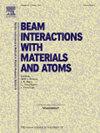通过共振后向散射和RACE-p分析工具快速标定MeV质子束能量
IF 1.4
3区 物理与天体物理
Q3 INSTRUMENTS & INSTRUMENTATION
Nuclear Instruments & Methods in Physics Research Section B-beam Interactions With Materials and Atoms
Pub Date : 2025-06-07
DOI:10.1016/j.nimb.2025.165762
引用次数: 0
摘要
MeV质子束的精确能量校准对离子束分析技术至关重要,但传统的依赖核反应的方法在可及性和效率方面存在局限性。本研究提出了一种使用石墨和聚酯薄膜样品的非卢瑟福共振后向散射的快速校准方案。通过分析后向散射光谱的鞍点特征,引入校正因子R(峰面积比)来减轻光束电流的不稳定性。自主开发的软件RACE-p能够自动批量处理光谱,将人工分析时间从几个小时减少到几分钟。实验结果表明,石墨(石墨)和聚酯薄膜(聚酯薄膜)的能量偏差分别为31.4 keV和30.8 keV。该方法为离子加速器装置中MeV质子束能量标定提供了一种标准化、高效的解决方案。RACE-p的集成提高了材料科学和核物理应用中质子束能量校准的分析可靠性和通量。本文章由计算机程序翻译,如有差异,请以英文原文为准。
Rapid energy calibration of MeV proton beams through resonant backscattering and the analysis tool RACE-p
Accurate energy calibration of MeV proton beams is critical for ion beam analysis techniques, yet conventional methods relying on nuclear reactions face limitations in accessibility and efficiency. This study presents a rapid calibration protocol using non-Rutherford resonance backscattering from graphite and Mylar film samples. By analyzing saddle-point features in backscattering spectra, the calibration factor R (ratio of peak areas) is introduced to mitigate beam current instability. A self-developed software RACE-p enables automated batch processing of spectra, reducing analysis time from several hours manually to just a few minutes. Experimental results revealed consistent energy deviations of 31.4 keV (graphite) and 30.8 keV (Mylar), validated by improved fitting accuracy post-calibration. This method offers a standardized and efficient solution for MeV proton beam energy calibration in ion accelerator facilities. The integration of RACE-p enhances analytical reliability and throughput in proton beam energy calibration for applications in materials science and nuclear physics.
求助全文
通过发布文献求助,成功后即可免费获取论文全文。
去求助
来源期刊
CiteScore
2.80
自引率
7.70%
发文量
231
审稿时长
1.9 months
期刊介绍:
Section B of Nuclear Instruments and Methods in Physics Research covers all aspects of the interaction of energetic beams with atoms, molecules and aggregate forms of matter. This includes ion beam analysis and ion beam modification of materials as well as basic data of importance for these studies. Topics of general interest include: atomic collisions in solids, particle channelling, all aspects of collision cascades, the modification of materials by energetic beams, ion implantation, irradiation - induced changes in materials, the physics and chemistry of beam interactions and the analysis of materials by all forms of energetic radiation. Modification by ion, laser and electron beams for the study of electronic materials, metals, ceramics, insulators, polymers and other important and new materials systems are included. Related studies, such as the application of ion beam analysis to biological, archaeological and geological samples as well as applications to solve problems in planetary science are also welcome. Energetic beams of interest include atomic and molecular ions, neutrons, positrons and muons, plasmas directed at surfaces, electron and photon beams, including laser treated surfaces and studies of solids by photon radiation from rotating anodes, synchrotrons, etc. In addition, the interaction between various forms of radiation and radiation-induced deposition processes are relevant.

 求助内容:
求助内容: 应助结果提醒方式:
应助结果提醒方式:


